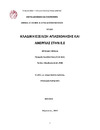| heal.creatorName | Τζερμιάς, Κωνσταντίνος | el |
| heal.creatorName | Τοτάκη, Ελευθερία | el |
| heal.creatorName | Tzermias, Konstantinos | en |
| heal.creatorName | Totaki, Eleftheria | en |
| heal.publicationDate | 2020-07-07 | |
| heal.identifier.primary | http://hdl.handle.net/20.500.12688/9568 | |
| heal.abstract | Η παρούσα μελέτη ασχολήθηκε με το θέμα της ανεργίας και ολοκληρώθηκε μέσα από έξι κεφάλαια, όπου πιο συγκεκριμένα το πρώτο κεφάλαιο έκανε λόγο για το φαινόμενο της ανεργίας και της φτώχειας εκτενέστερα. Επίσης αναφέρθηκε στις ταξινομήσεις της ανεργίας και την ένταξη των γυναικών στην αγορά εργασίας αλλά και τη νεανική ανεργία και την ανεργία των αποφοίτων ΑΕΙ οι οποίοι δυσκολεύονται να βρουν εργασία κατόπιν της αποφοίτησής τους. Λόγος έγινε και για τη χαμηλή παραγωγικότητα των νέων και την έλλειψη διασύνδεσης εκπαιδευτικού συστήματος και αγοράς εργασίας αλλά και για τη περιορισμένη κινητικότητα των νέων μέσα στα διάφορα είδη της ανεργίας όπως είναι η κυκλική και η δομική. Δόθηκαν στοιχεία επίσης και για τα ποσοστά ανεργίας στην χώρα της Ιαπωνίας. Έπειτα, το δεύτερο κεφάλαιο εμβάθυνε στην ανεργία στην ευρωπαϊκή ένωση και τους κοινούς στόχους. Δεν παραλήφθηκε να αναφερθεί η Ευρωπαϊκή κεντρική τράπεζα και οι εθνικές κεντρικές τράπεζες και η συνθήκη του Μάαστριχτ, όπως και δόθηκαν στοιχεία για τη κεντρική τράπεζα των ΗΠΑ αλλά και το ποσοστό της ανεργίας στην Ευρώπη γενικότερα. Άξιο αναφοράς στάθηκαν οι μεταβολές στις μορφές απασχόλησης στην Ε.Ε.-27, όπως επίσης και οι δείκτες ανεργίας στις χώρες της ευρωζώνης. Το τρίτο κεφάλαιο έκανε λόγο για τις συγκρίσεις χωρών ανά κλάδο και η εργασία έκλεισε με τα τελικά συμπεράσματα. | el |
| heal.abstract | This study discussed the issue of unemployment and was completed through six chapters, where the first chapter discussed about the phenomenon of unemployment and poverty more extensively. Also, the unemployment classifications were discussed and the inclusion of women in the labor market, as well as youth unemployment and unemployment among university graduates who find it difficult to find work after their graduation. There was also a reference to the low productivity of young people and the lack of interconnection between the education and labor market and the limited mobility of young people in the various types of unemployment such as cyclical and structural. Data was also provided on unemployment rates in the country of Japan. The second chapter then deepened into the EU’s unemployment and its common goals. The European Central Bank and the National Central Banks and the Maastricht Treaty were also mentioned, and data on the US central bank and the unemployment rate in Europe in general. Changes in employment patterns in the EU-27 were pointed out, as well as unemployment rates in the euro area countries. The third chapter presented country comparisons by industry and the study was completed with the final conclusions. | en |
| heal.language | Ελληνικά | el |
| heal.language | Greek | en |
| heal.academicPublisher | Τ.Ε.Ι. Κρήτης, Σχολή Διοίκησης και Οικονομίας (Σ.Δ.Ο), Τμήμα Λογιστικής και Χρηματοοικονομικής | el |
| heal.academicPublisher | T.E.I. of Crete, School of Management and Economics (SDO), Department of Accounting and Finance | en |
| heal.title | Κλαδική εξέλιξη απασχόλησης και ανεργίας στην Ευρωπαϊκή Ένωση | el |
| heal.title | Sector evolution of employment and unemployment in European Union. | en |
| heal.type | Πτυχιακή Εργασία | el |
| heal.type | Bachelor thesis | en |
| heal.keyword | απασχόληση, ανεργία, οικονομικός δείκτης, φτώχεια, αγορά εργασίας | el |
| heal.keyword | employment, unemployment, economic indicator, poverty, labor market | en |
| heal.access | free | el |
| heal.advisorName | Δημοτίκαλης, Ιωάννης | el |
| heal.advisorName | Dimotikalis, Ioannis | en |
| heal.advisorID.email | jdim@hmu.gr | |
| heal.academicPublisherID | Τ.Ε.Ι. Κρήτης | el |
| heal.academicPublisherID | T.E.I. of Crete | en |
| heal.fullTextAvailability | true | el |
| tcd.distinguished | false | el |
| tcd.survey | false | el |


